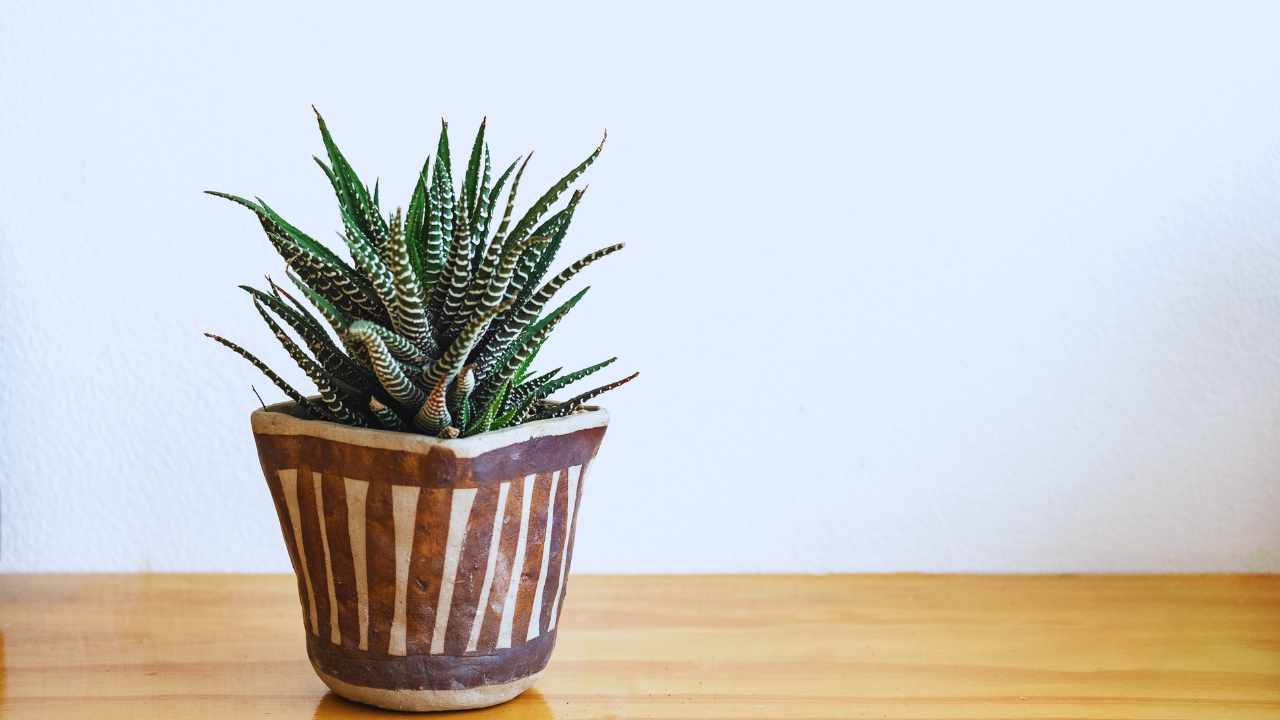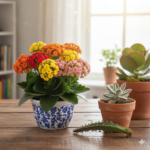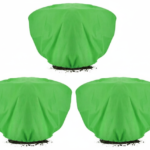Growing a zebra plant (Aphelandra squarrosa) can be a rewarding experience for plant lovers, thanks to its eye-catching dark green leaves adorned with bold white stripes. Native to Brazil’s tropical rainforests, this stunning houseplant brings an exotic touch to any indoor space. However, caring for a zebra plant can be tricky if you’re unfamiliar with its specific needs. Each aspect of care is crucial in keeping your zebra plant vibrant and healthy, from finding the right light to maintaining proper humidity. Without the right conditions, you might encounter common issues like yellowing leaves or drooping stems, which can be frustrating for any plant owner. But with the proper knowledge and techniques, you can create an environment where your zebra plant thrives. In this guide, I’ll cover essential tips for watering, fertilizing, troubleshooting issues, and advice on repotting and propagating your plant. Whether you are a beginner or an experienced gardener, these expert tips will help you cultivate a thriving zebra plant that enhances your indoor garden.
What is a Zebra Plant?

Zebra plant, scientifically known as Aphelandra squarrosa, is a popular tropical houseplant native to the rainforests of Brazil. It thrives in warm, humid environments that mimic its natural habitat. The zebra plant is well-loved for its dramatic foliage and occasional bright blooms, making it a striking addition to any indoor garden.
Description and Origin
The zebra plant belongs to the Acanthaceae family and is found primarily in the shaded understories of Brazil’s tropical regions. It grows naturally in environments with high humidity, filtered sunlight, and rich, well-draining soil. Its adaptability to indoor settings has made it a favorite among plant enthusiasts worldwide.
Appearance and Unique Features
The zebra plant is characterized by its large, dark green leaves with prominent white veins resembling a zebra’s stripes—hence its name. The leaves are glossy and oval-shaped and can grow several inches long. When given proper care, the plant produces bright yellow, cone-shaped flower bracts that last for several weeks. These flowers contrast the lush green foliage, making the zebra plant an eye-catching indoor choice.
Ideal Growing Conditions for Zebra Plant

Creating an environment that mimics its tropical origins is essential to keep your zebra plant thriving. Here’s a breakdown of the ideal growing conditions:
- Light Requirements
- Zebra plants prefer bright, indirect sunlight. Direct sunlight can scorch their leaves, while low light may cause the plant to lose its vibrant leaf patterns.
- Place the plant near a window with filtered light or use sheer curtains to diffuse direct sunlight.
- Temperature
- For optimal growth, maintain a temperature range of 65-75°F (18-24°C). Zebra plants are sensitive to cold drafts, so keep them away from windows or doors that might expose them to cooler air.
- Avoid temperatures below 60°F (15°C), as this can harm the plant.
- Humidity
- Zebra plants thrive in high humidity levels of around 60-70%. Increase humidity by misting the leaves, using a humidifier, or placing a water tray near the plant.
- Grouping plants can also boost humidity levels.
- Soil Requirements
- Use a well-draining, peat-based potting mix with added perlite or orchid bark to improve drainage and airflow.
- The soil should retain moisture but never become soggy to prevent root rot.
How to Water Zebra Plants Properly?
Proper watering is crucial for the health of your zebra plant. Here are some guidelines to ensure it gets the right amount of moisture:
- Watering Frequency
- Zebra plants prefer consistently moist soil that is not waterlogged. Check the top inch of the soil—if it feels dry, it’s time to water.
- Typically, watering once a week works well, but this may vary depending on your indoor environment’s temperature and humidity.
- Water Quality
- Use room-temperature, filtered, or distilled water to prevent mineral buildup. Tap water with high chlorine or fluoride content can damage the plant over time.
- Let the water sit for 24 hours before using it to allow any chemicals to evaporate.
- Watering Method
- Water the plant thoroughly until you see water draining from the bottom of the pot. This ensures that the roots are well-hydrated.
- Avoid letting the plant sit in standing water; empty the saucer to prevent root rot.
- Signs of Overwatering and Underwatering
- Overwatering: Yellowing leaves and soft, mushy stems.
- Underwatering: Dry, crispy leaf edges and drooping leaves.
Repotting a Zebra Plant (Aphelandra squarrosa)
Repotting a Zebra Plant is an essential part of its care routine, as it helps prevent root-bound conditions and provides fresh nutrients for the plant’s growth. Here’s how to properly report your Zebra Plant:
When to Repot
- Every 1-2 Years: Repot your Zebra Plant every 1 to 2 years, preferably in the spring or early summer when the plant is actively growing.
- Signs It Needs Repotting: If the roots are coming out of the drainage holes or growth has slowed, it’s likely time to repot.
Choosing the Right Pot
- Size: Select a pot that is 1-2 inches larger in diameter than the current one. A pot that is too large may lead to overwatering.
- Drainage: Ensure the pot has drainage holes to prevent waterlogging, which can cause root rot.
Soil Requirements
- Well-Draining Soil: Zebra Plants prefer a light, well-draining potting mix. You can use a standard houseplant mix, but adding a bit of perlite or coarse sand helps improve drainage.
- Slightly Acidic: The soil should be slightly acidic, with a pH between 5.5 and 6.5, which is ideal for Zebra Plants.
Steps for Repotting
- Water Before Repotting: Water the plant the day before repotting to soften the soil and make it easier to remove the plant.
- Remove the Plant from Its Pot: Gently tilt the plant and tap the sides of the pot to loosen it. Carefully lift the plant, holding it by the base of the stem.
- Inspect the Roots: Check the roots for any signs of rot or damage. Trim off any brown or mushy roots with sterilized scissors.
- Prepare the New Pot: Add a layer of fresh potting mix at the bottom of the new pot. Place the plant in the center, and fill around the roots with more potting mix, gently pressing it down.
- Water Thoroughly: After repotting, water the plant thoroughly to settle the soil. Ensure that the water drains out of the bottom to avoid standing water.
Aftercare
- Lighting: Keep the plant in a location with bright, indirect light. Avoid direct sunlight, as the plant is more sensitive after repotting.
- Humidity: Zebra Plants love humidity, so mist the plant regularly or use a humidity tray to maintain moisture levels.
- Avoid Fertilizing Immediately: Wait 4-6 weeks before fertilizing; the fresh potting mix should provide enough nutrients.
Pruning and Maintaining Shape for Zebra Plant (Aphelandra squarrosa)

The Zebra Plant is known for its striking, glossy green leaves with white veins. Proper pruning and shaping are essential to encourage healthy growth and maintain its aesthetic appeal. Here’s a step-by-step guide to help you prune and shape your Zebra Plant:
When to Prune
- Timing: The best time to prune a Zebra Plant is during the active growing season, typically in spring or early summer. Avoid heavy pruning in winter as the plant enters a dormant phase.
- After Blooming: Once the flowers fade, it’s an excellent time to prune, as it encourages the plant to produce new growth.
Tools Needed
- Pruning Shears: Use sharp, clean ones to avoid damaging the plant.
- Sanitizer: Sterilize your tools with alcohol or bleach solution to prevent infections.
Pruning Steps
- Inspect the Plant: Look for dead, damaged, or diseased leaves and stems. These should be your primary targets for removal.
- Cutting Back Leggy Growth: Zebra Plants can become leggy over time. To maintain a bushy shape, prune leggy stems just above a set of leaves. This encourages side shoots to grow.
- Remove Dead Flowers: Once the plant has finished flowering, remove the spent flower stalks to tidy up its appearance and encourage new growth.
- Shape the Plant: Trim around the plant to maintain a balanced, compact shape. To avoid stressing it, don’t remove more than one-third of the plant at a time.
Tips for Healthy Maintenance
- Pinching: For younger plants, regularly pinch off the tips of stems to promote fuller growth.
- Avoid Over-Pruning: Zebra Plants are sensitive, and excessive pruning can shock them. Keep pruning light unless the plant is overgrown or unhealthy.
- Maintain Proper Care: After pruning, ensure the plant receives adequate light (indirect, bright light) and consistent moisture to help it recover and thrive.
Fertilizing a Zebra Plant (Aphelandra squarrosa)
Fertilizing your Zebra Plant properly is essential for promoting healthy growth and vibrant foliage. Here’s a guide to fertilizing your Zebra Plant:
When to Fertilize
- During the Growing Season: Fertilize during the plant’s active growing period in spring and summer. This is when the plant needs extra nutrients for growth.
- Avoid Winter Fertilizing: In the fall and winter, the plant enters a dormant phase, so avoid fertilizing during these months to prevent stress.
Choosing the Right Fertilizer
- Balanced Fertilizer: Use a balanced, water-soluble fertilizer with an equal ratio of nitrogen (N), phosphorus (P), and potassium (K), such as a 10-10-10 or 20-20-20 formula.
- Diluted Strength: Zebra Plants are sensitive to solid fertilizers. Dilute the fertilizer to half the recommended strength to avoid burning the roots or leaves.
How to Fertilize
- Water First: Always water the plant before applying fertilizer to prevent root burn from concentrated nutrients.
- Fertilizer Application: Apply the diluted fertilizer solution to the soil after watering. Avoid getting fertilizer on the leaves, as this can cause damage.
- Frequency: Fertilize for optimal results every 2-4 weeks during the growing season. If the plant shows signs of rapid growth, you can fertilize it more frequently but monitor it for signs of over-fertilization.
Signs of Over-Fertilization
- Brown Leaf Tips: If the tips of the leaves turn brown, it could be a sign of over-fertilization or salt buildup in the soil.
- Yellowing Leaves: Excess fertilizer can cause leaf discoloration, yellowing, or wilting.
Organic Fertilizer Options
- If you prefer organic fertilizers, you can use compost tea or a diluted fish emulsion, which provides a gentler and more natural nutrient source. Apply in the same manner as chemical fertilizers, ensuring proper dilution.
Common Pests and Diseases
Identifying Common Pests
- Spider Mites: Tiny red or yellowish mites that spin delicate webs on the undersides of leaves. They cause yellowing or speckled foliage.
- Mealybugs: White, cotton-like masses on the leaves and stems. They suck the sap, leading to weakened and wilting plants.
- Aphids: Small, soft-bodied insects often found in clusters on new growth. Aphids can cause leaves to curl or distort.
- Scale: Brown or black oval-shaped pests that attach to stems and leaves. They produce a sticky residue called honeydew, which can lead to mold.
Preventing and Treating Diseases
- Root Rot: Caused by overwatering and poor drainage. Symptoms include wilting and yellowing leaves. To prevent it, ensure well-draining soil and avoid waterlogging. If root rot occurs, trim off affected roots and repot the plant in fresh soil.
- Powdery Mildew: A white, powdery substance that forms on leaves, especially in humid environments. Improve air circulation and reduce humidity around the plant. Treat affected areas with a fungicide or a homemade baking soda and water solution.
- Leaf Spot: Brown or black spots on leaves caused by fungal or bacterial infections. Avoid overhead watering, and remove infected leaves to prevent the spread. Use a fungicide if the problem persists.
Propagating Zebra Plant

Methods of Propagation
- Stem Cuttings: This is the most common method for propagating Zebra Plants.
- Select a healthy stem with 2-3 leaf nodes.
- Cut just below a leaf node with sterilized scissors.
- Remove the lower leaves and dip the cut end in rooting hormone to encourage root growth.
- Place the cutting in a pot with well-draining soil, and keep it in a warm, humid environment with indirect light.
- Air Layering: Another method involves creating a slight wound in the stem and encouraging roots to grow before cutting the stem from the parent plant.
- Make a small cut on a healthy stem and wrap it in moist sphagnum moss.
- Secure with plastic wrap and keep the moss damp.
- Once roots form, cut the stem below the new root growth and plant it in a new pot.
Tips for Successful Propagation
- Humidity: Zebra Plants love humidity, so using a plastic cover or a humidity dome can speed up root formation.
- Indirect Light: Keep cuttings in bright, indirect light to encourage growth without causing stress.
- Patience: Roots may take several weeks to form, so be patient and maintain consistent care.
Troubleshooting Common Issues
Yellowing Leaves
- Causes:
- Overwatering: Check the soil moisture and allow it to dry between waterings.
- Nutrient Deficiency: Make sure you fertilize during the growing season with a balanced fertilizer.
- Inadequate Light: Zebra Plants require bright, indirect light. Yellowing leaves may indicate too much or too little light.
- Solution: Adjust watering, check light exposure, and ensure the plant gets proper nutrients.
Drooping Leaves
- Causes:
- Underwatering: The most common cause of drooping leaves is dehydration. Check the soil for dryness.
- Overwatering: Excess water can cause root rot, leading to drooping.
- Low Humidity: Zebra Plants thrive in high humidity, and dry air can cause leaves to droop.
- Solution: Water the plant properly, improve drainage, and increase humidity levels using a humidifier or misting the plant.
No Growth
- Causes:
- Dormancy: Zebra Plants tend to slow down or stop growing during the colder months.
- Insufficient Light: Lack of light can stunt growth.
- Nutrient Deficiency: If the plant hasn’t been fertilized, it may lack the nutrients needed for growth.
- Solution: Provide adequate light, ensure the plant is in its active growing season, and apply a balanced fertilizer during the spring and summer.
- Seasonal Care Tips
Care During Summer
- Watering: Increase watering frequency as the plant grows more actively in summer. Ensure the soil remains moist but not waterlogged.
- Humidity: Zebra Plants thrive in high humidity, so mist the leaves regularly or place the pot on a humidity tray.
- Light: Provide bright, indirect sunlight. Too much direct sunlight can scorch the leaves, while too little light may stunt growth.
Care During Winter
- Watering: Reduce watering during the colder months, allowing the soil to dry out slightly between waterings. The plant will enter a dormant phase.
- Light: Move the plant to a brighter location if necessary, as winter light levels are lower.
- Temperature: Keep the plant in a warm room, ideally between 60-75°F (15-24°C), away from drafts or cold windows.
- Humidity: Increase indoor humidity with a humidifier or by misting the plant regularly, as indoor air tends to be drier in winter.
Signs Your Zebra Plant is Thriving
Healthy Leaf Characteristics
- Glossy Leaves: Healthy Zebra Plant leaves should be vibrant green with clearly defined white veins.
- Upright and Firm: Leaves should stand firm and upright, with no signs of wilting or curling.
New Growth Patterns
- New Leaves: During the growing season, look for new leaves emerging from the center of the plant.
- Flowering: Zebra Plants can produce beautiful yellow bracts, a sign of optimal care and a healthy plant.
Decorating with Zebra Plant
Best Places to Keep Zebra Plants in Your Home
- Living Room: Place the Zebra Plant near a window with filtered light to showcase its bold foliage.
- Bathrooms: Bathrooms with natural light are ideal for Zebra Plants due to the high humidity.
- Home Office: Zebra Plants add a tropical touch to workspaces, and their striking leaves can complement various interior styles.
Styling Tips
- Containers: Choose decorative pots in neutral tones to highlight the plant’s vibrant leaf patterns.
- Groupings: Zebra Plants pair well with other houseplants, creating a lush, green display in your living space.
- Shelves and Corners: Place the plant on shelves or corners to draw attention to its unique appearance, adding visual interest to the room.
Benefits of Having a Zebra Plant Indoors
Air Purification
- Zebra Plants contribute to indoor air purification by absorbing carbon dioxide and releasing oxygen, creating a fresher, cleaner environment.
Aesthetic Appeal
- The striking green leaves with bold white veins make Zebra Plants a popular choice for adding a touch of tropical elegance to any room. Their compact size makes them versatile for decorating small or large spaces.
FAQs
How often should I water my Zebra Plant?
Water your Zebra Plant when the top inch of soil feels dry. During summer, water more frequently to keep the soil consistently moist. In winter, reduce watering to allow the soil to dry slightly between waterings.
Why are my Zebra Plant’s leaves turning yellow?
Yellowing leaves can be caused by overwatering, underwatering, or lack of light. Check the soil moisture and adjust your watering routine accordingly. Ensure the plant receives enough indirect light.
Can Zebra Plants survive in low light?
Zebra Plants prefer bright, indirect light. While they can tolerate low light for short periods, they will not thrive and may lose their vibrant leaf coloration in low-light conditions.
What is the best way to propagate Zebra Plants?
The easiest way to propagate a Zebra Plant is through stem cuttings. Cut a healthy stem below a node, remove the lower leaves, dip it in the rooting hormone, and place it in a well-draining potting mix.
How do I know if my Zebra Plant needs repotting?
If the roots are growing out of the drainage holes or if the plant has become root-bound, it’s time to repot. Slow growth or the plant becoming top-heavy may also be signs that it needs a larger pot.
Conclusion
In conclusion, the Zebra Plant (Aphelandra squarrosa) is a stunning houseplant that, with proper care, can thrive and enhance your indoor space. Focus on providing bright, indirect light, maintaining consistent humidity, and watering appropriately to avoid overwatering or underwatering. Regular pruning, repotting, and occasional fertilizing during the growing season will keep the plant healthy. Whether you’re propagating or troubleshooting common issues, patience and attention to detail will lead to success. With its bold, striped leaves and air-purifying benefits, the Zebra Plant is a rewarding addition to any home, offering beauty and functionality.







